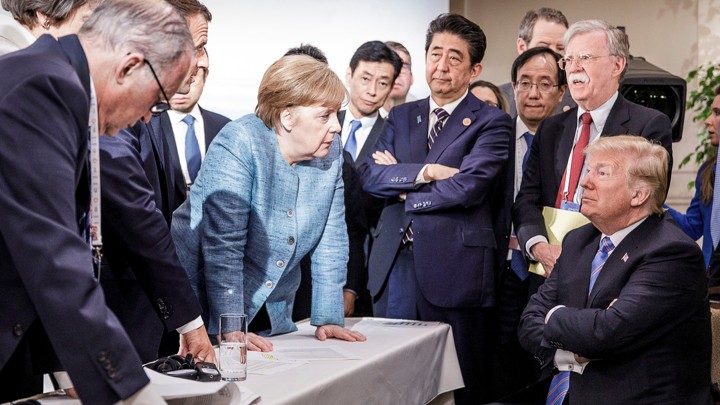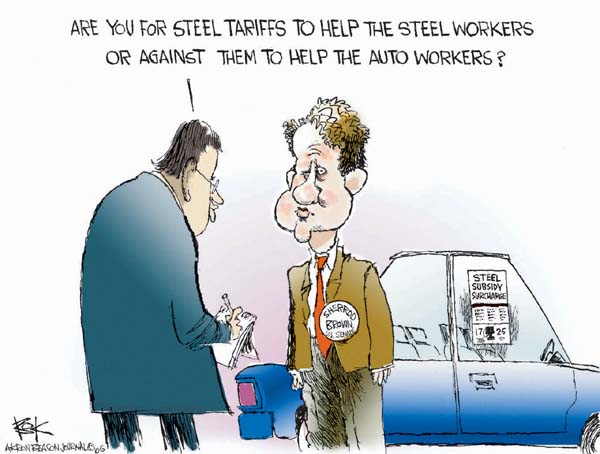Luke Pretz and Bill Resnick
July 3, 2018

German Chancellor Angela Merkel and Donald Trump during the G7 meeting in Quebec, June 9, 2018
JESCO DENZEL / HANDOUT / REUTERS
While Trump has been careening between policy positions on near everything (China, the Koreas, Syria, NATO, DACA, and health care policy among others), he has in his public statements and tweets remained dedicated to the economic nationalism that was a central plank in his campaign platform. In recent weeks he has kept himself in the headlines announcing aggressive tariffs on steel and aluminum imports from Canada, Mexico, the European Union, also his blunderbuss tariffs on Chinese manufacture perhaps igniting a mini-trade war, his obsession with combating the US trade deficit, and his tantrum at the G-7 conference snubbing his European counterparts and especially attacking Canada. These have sparked a heated if diffuse discussion within the media and among conservative and liberal politicians that has had the effect of assisting Trump while reinforcing neoliberal trade policy.
Popular Media, Their Trade Discourse
First, the media accepted Trump’s economic nationalist theatrics as the real Trump, hardly mentioning that the Trump administration’s actual trade policy, as evidenced in the written record in the NAFTA and China negotiations, includes the adoption of the intellectual property and free market finance program of the TTP. Trump of course renounced the TPP in his campaign and withdrew from its negotiation, though it’s not impossible that Trump has not read and does not know the proposals made by his trade negotiators. In any event, media failure to look critically at Trump’s protectionist trade rhetoric and policy operates to maintain and shore up support from his base and the other members of the protectionist coalition while it further improves his standing with Wall Street and the rest of the plutocrats, already happy with his tax breaks and his down the line conservative economic and environmental policies.

Second, the current discussion in establishment media poses trade policy as a choice between “free trade” and “protectionism.” In the media’s analysis the opposition to Trump’s theatrical protectionism comes from familiar sources — right wing free market ideologues of the Republican Party like Paul Ryan and the dominant neoliberal wing of the Democratic party. Though rivals on many other issues, both groups rally around the free market and its magical optimal allocation of resources. This framing of the issue thus continues media mugging of the most radical of labor’s proposals on U.S. trade policy, namely “Fair Trade” as the alternative to either free trade or protection. In fair trade international agreements would contain binding enforceable worker rights and environmental protections that would at best prevent and at the very least slow the global race to the bottom that free trade agreements prompt and intensify. Fair trade was cast as “protectionist,” as exemplified in the New York Times’ treatment of the trade bills then being negotiated with China and African nations.
Still, the advocates of fair trade were strong enough in 1994 to compel President Clinton to submit and ratify two supplements to NAFTA creating environmental protections and labor rights. Both however proved largely toothless or hardly enforced. And later the advocates of fair trade — labor rank and file and leadership, socialists, environmentalists – suffered further defeat in the struggle against the World Trade Organization. These repeated defeats reflected the weakening power of labor and other left groups in the US and abroad and the increasing power of international finance capital as neoliberal forces consolidated power.
Of course at the local level the unions were desperate, unable to stop the long wave of factory closing and defeat (this of course partly the product of business unionism that operated to pacify and undermine class solidarity). Leadership and the rank and file grabbed for any available life raft. Protectionism became the default position within the mainline labor movement and labor’s public face. And protection did succeed in a few cases, especially when Asian auto companies were forced to accept quotas on their auto and truck exports, some of which survive. But of course protectionism was disastrous for the class, undermining the class solidarity necessary to challenge “free market” capital prospecting for cheap compliant labor.
Fashioning Left Trade Policy and Practice

Fair trade, not free trade, Seattle 1999
“It’s an ill wind that blows nobody any good,” an old proverb. Trump’s opportunistic protectionism and its very limited and deceptive coverage in mainstream media does offer an organizing opportunity for the left, particularly in an era of malignant climate change whose fierce winds will likely do nobody any good, except maybe the undertakers.
First, we can discuss the reality of “free trade,” that it is hardly free but in fact a dense network of trade regulations, which in its current form privileges the corporate predators of the industrialized world. And we could again demonstrate that workers in the US and abroad as well as peasants and indigenous peoples have overwhelmingly been harmed by neoliberal economic policy.
Second, we can point out that tariffs and other trade policies are often used as weapons to wield in conflicts between rival sections of the capitalist class. Thus the opponents of Trump’s recent tariffs point out that U.S. steel and aluminum producers benefit from the relatively high prices of imported steel and aluminum, but downstream industries are harmed, as are industries that export to countries that impose counter-tariffs. In this battle among corporate interests the concerns of the broad working class go largely undiscussed in popular media, but for token references to keep fractions of the working class invested in the capitalist interest favored by the particular media outfit. Again the only options on the table benefit capital. While some small section of workers may end up better off as a result of one policy or the other, most will lose. One thing is certain: neither side of the debate has workers’ interests in mind.
Third, we can point out that Trump is using trade as a cudgel to use against political and economic rivals. Trump realizes that the massive US economy gives him the power to hammer on nations voicing opposition to his policies. Thus he’s attempting to force China to open its economy to TPP- like provisions, and apparently less acceptable to China, to surrender requirements for technology transfer on companies doing business in China. These transfers enrage the neo-cons, other militarist hawks, and apparently Trump who see them as enabling China to challenge U.S. domination of military robot and space weapon development.
Trump is also angry at the European states that have voiced intention to maintain trade with Iran after the U.S. exit from the Iran nuclear deal. Trump and the neo-cons are seeking to force Europe to cooperate in isolating Iran to the benefit of Arabia, Israel, and big U.S. oil. And he apparently thinks his bluster directed to Mexico and Canada will help in renegotiating NAFTA. All this bluff and threat creates danger to U.S. hegemony and the world economy. Though today, with the rise of the far right in the U.S. and Europe and anti-democratic leadership strengthening globally, the decline of the U.S. empire in this way might also be an ill wind that will blow nobody any good.
Fourth, to counter the rise of the right, we could offer an alternative international trade and development policy. This would be based in the principles of fair trade, with environmental and worker and union protection provisions, these broadened by bans on national subsidies for corporate relocation, room for the developing world to shield some national industries and restrict the free flow of speculative capital, and requirements for technology transfer for environmental purposes, particularly renewable energy production and agriculture. As early as the Battle of Seattle (its temporary coalition of Turtles and Teamsters) and the emergence of the anti-globalization movement, fair trade policy has brought together labor and environmentalists. More recently it brought together the coalition that had a key role in building the public opposition that ultimately defeated the TPP. In an age of increasingly virulent global warming, those politics could challenge for hegemony.
Fair trade policy has for some time offered the left opportunity for “radical” or “non-reformist” or “transitional” reform organizing. Fair trade is inherently internationalist, opposes sex, race, religious, and ethnic prejudices and discrimination, and recognizes a common enemy. It’s explicit about the need to work together internationally and avoid being played off against one another. And we are well into an age in which human survival requires vast reduction of greenhouse gas emissions. Discussions of international trade, development, and technology transfer are ideal for proposing and demonstrating the necessity and feasibility of radical economic reconstruction including energy production, agriculture, transportation, habitation, and urban form to insure our survival. This reconstruction in aggregate amounts to a radically democratic egalitarian socialist vision for the next period.
The planet and this country are alive with reform movements and campaigns. Given that working in reform campaigns for radical ends is fundamental to building the next left, the left might fashion and fight for trade and development policy in this way.
